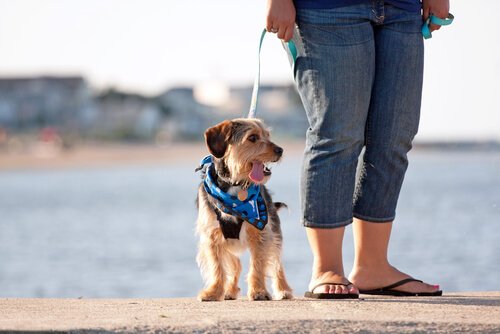How to Teach Your Dog Self-Control

Self-control seems to be a quality that’s hard to come by in this world. This quality is very difficult to cultivate, and it’s even harder to teach. And what about pets? Is it possible to teach your dog self-control?
Since we were little, our parents have tried to instill this ability in us, and we try to pass it on to our children. This is easy when there’s open communication because we can vocalize the values and desires that we expect from our children.
However, things get complicated when our “student” can’t talk and can’t rationally understand what we’re trying to tell him. Of course, we’re talking about our pets.
Regardless, it’s still important to teach your dog self-control. That’s because he’ll need it for everyday things like eating, drinking and interacting with others, and even taking care of his business.
You might think that it’s complicated and difficult to teach your dog self-control. But we’ll give you some practical advice to help you achieve this before you know it.
What is self-control?

Firstly, it’s important to know exactly what it is that we’re talking about. So, we have to define self-control and know in which situations dogs have difficulty showing it. That way, we can help him develop it.
Self-control, as the word indicates, is to control one’s impulses to act inappropriately in certain situations. Many of these impulses are controlled by our subconscious or are innately inside of us. Pets can also be influenced by these instincts. Because of that, it’s a difficult thing to control.
When is it hard for dogs to show self-control?
- When it’s time to eat. It’s almost impossible for a dog to eat in a relaxed way. They seem to devour the food as if they haven’t eaten in days.
- While he’s out for a walk. We probably don’t even have to tell you about this one. We’re sure that most of the times you walk your dog, it seems like he’s the one walking you.
- When he greets people. Of course, when you get home from a long day, you love the fact that your friend’s happy to see you. But, he’s so excited that sometimes he ends up hurting you when he rushes to greet you. And, he could end up accidentally hurting your friends and family too.
There are still more instances when our pets don’t show self-control. For example, when they need to “do their business”, but they’re stuck inside. But let’s just focus on two aspects where you can teach your dog self-control: food and walks.
Teach your dog self-control at mealtimes
Some dogs may growl at you if you touch them while they’re eating, and they may even try to bite you. They’ll even do this with their owners. However, this is poor behavior and is caused by a lack of self-control, so you have to end this habit. But, how?
Dogs are herd animals and are guided by a leader. At home, you can teach him that you’re the leader. One of the ways to do this is by not letting your dog eat before you or at the same time as you. First the leaders eat, then the rest of the pack.
Also, you shouldn’t let him around the table if he’s going to beg or jump on you. From a young age, you should teach him to stay in his place while you eat, like in his bed. Then, when it’s time to give him his food, don’t let him jump, bark or get excited. Instead, teach him to sit down and wait until you tell him he can eat.
By doing this, you’ll be teaching him how to be a submissive, quiet dog.
Improve self-control during his walks

Taking your dog for a walk can be a daunting task if he always tries to run ahead of you. So, to improve this aspect, you have to start from home.
Dogs get overly excited when their owners show them their leash because they know it’s time to go outside. So, before putting any of your dog’s walking accessories on him, you should wait until he is calm. Normally, this won’t take any longer than 10 minutes.
You can sit down with all of his accessories, just looking at them, and wait until he calms down. Then, you can put his leash on while you’re softly speaking to him and explaining that he should be calm and relaxed. Don’t expect him to get this on the first try. However, with patience and perseverance, you’ll both get there.
During the walk, keep talking to him calmly. If necessary, you can even pick him up and put him at your side, where you want him to stay.
Self-control seems to be a quality that’s hard to come by in this world. This quality is very difficult to cultivate, and it’s even harder to teach. And what about pets? Is it possible to teach your dog self-control?
Since we were little, our parents have tried to instill this ability in us, and we try to pass it on to our children. This is easy when there’s open communication because we can vocalize the values and desires that we expect from our children.
However, things get complicated when our “student” can’t talk and can’t rationally understand what we’re trying to tell him. Of course, we’re talking about our pets.
Regardless, it’s still important to teach your dog self-control. That’s because he’ll need it for everyday things like eating, drinking and interacting with others, and even taking care of his business.
You might think that it’s complicated and difficult to teach your dog self-control. But we’ll give you some practical advice to help you achieve this before you know it.
What is self-control?

Firstly, it’s important to know exactly what it is that we’re talking about. So, we have to define self-control and know in which situations dogs have difficulty showing it. That way, we can help him develop it.
Self-control, as the word indicates, is to control one’s impulses to act inappropriately in certain situations. Many of these impulses are controlled by our subconscious or are innately inside of us. Pets can also be influenced by these instincts. Because of that, it’s a difficult thing to control.
When is it hard for dogs to show self-control?
- When it’s time to eat. It’s almost impossible for a dog to eat in a relaxed way. They seem to devour the food as if they haven’t eaten in days.
- While he’s out for a walk. We probably don’t even have to tell you about this one. We’re sure that most of the times you walk your dog, it seems like he’s the one walking you.
- When he greets people. Of course, when you get home from a long day, you love the fact that your friend’s happy to see you. But, he’s so excited that sometimes he ends up hurting you when he rushes to greet you. And, he could end up accidentally hurting your friends and family too.
There are still more instances when our pets don’t show self-control. For example, when they need to “do their business”, but they’re stuck inside. But let’s just focus on two aspects where you can teach your dog self-control: food and walks.
Teach your dog self-control at mealtimes
Some dogs may growl at you if you touch them while they’re eating, and they may even try to bite you. They’ll even do this with their owners. However, this is poor behavior and is caused by a lack of self-control, so you have to end this habit. But, how?
Dogs are herd animals and are guided by a leader. At home, you can teach him that you’re the leader. One of the ways to do this is by not letting your dog eat before you or at the same time as you. First the leaders eat, then the rest of the pack.
Also, you shouldn’t let him around the table if he’s going to beg or jump on you. From a young age, you should teach him to stay in his place while you eat, like in his bed. Then, when it’s time to give him his food, don’t let him jump, bark or get excited. Instead, teach him to sit down and wait until you tell him he can eat.
By doing this, you’ll be teaching him how to be a submissive, quiet dog.
Improve self-control during his walks

Taking your dog for a walk can be a daunting task if he always tries to run ahead of you. So, to improve this aspect, you have to start from home.
Dogs get overly excited when their owners show them their leash because they know it’s time to go outside. So, before putting any of your dog’s walking accessories on him, you should wait until he is calm. Normally, this won’t take any longer than 10 minutes.
You can sit down with all of his accessories, just looking at them, and wait until he calms down. Then, you can put his leash on while you’re softly speaking to him and explaining that he should be calm and relaxed. Don’t expect him to get this on the first try. However, with patience and perseverance, you’ll both get there.
During the walk, keep talking to him calmly. If necessary, you can even pick him up and put him at your side, where you want him to stay.
This text is provided for informational purposes only and does not replace consultation with a professional. If in doubt, consult your specialist.








